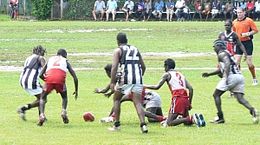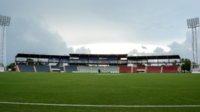Australian rules football in the Northern Territory
This article needs additional citations for verification. (October 2019) |
| Australian rules football in the Northern Territory | |
|---|---|
 Tiwi Islands Football League Grand Final 05/06 at Nguiu stadium. Mulluwurri vs Pumurali | |
| Governing body | AFL Northern Territory |
| First played | February 1916, Darwin |
| Registered players | 10,038 (2019)[1] |
Club competitions | |
Audience records | |
| Single match | 17,500 (2002). (AFL pre-season practice) Aboriginal All-Stars vs Carlton. (Marrara Oval, Darwin) |
Australian Football in the Northern Territory has a history dating back to the 1910s and is the most popular sport in the territory, particularly with indigenous Australian communities in Darwin, Alice Springs and the Tiwi Islands.
18% of all Territorians in 2017 participated in Australian Football,[2] the highest participation in Australia (and second worldwide only to Australian rules football in Nauru). The sport also produces more professional Australian Footballers per capita in the Australian Football League than any other state or territory.
The Northern Territory is home to several representative teams, most notably the Aboriginal All-Stars, but also the Northern Territory Thunder, the Northern Territory Football Club (that plays in the QAFL) and now in the NEAFL, an elite competition on the Eastern seaboard of Australia. Also the Flying Boomerangs represent Australia internationally and the Northern Territory has a strong local competition, the Northern Territory Football League.
History[]


The first recorded match of Australian Football in Darwin was played in February 1916 on Darwin Town Oval.
The Northern Territory Football League chose to play in the Northern Territory's 'wet season', primarily due to hard playing surfaces during the 'dry season'. Games were played on the Esplanade or Town Oval.[3] Most other leagues in Australia operate during the winter, but since the Territory does not have a winter, it is played at different times. The Wanderers Football Club were the founding members of the league in 1916.
John Pye and Andy Howley introduced Australian rules football to the Tiwi Islands in 1941, which grew to become the most popular sport on the islands. The Tiwi Islands Football League is a strong competition which feeds players into the NTFL. Skills of the TIFL players are widely celebrated. The TIFL Grand Final is the largest event on the island and a major tourist drawcard.
In 1991, Marrara Oval was increased in capacity, and became the new home for the NTFL and AFL matches.
In 1991, Darwin hosted the first Arafura Games, the first international competition to include the sport of Australian Rules, and local teams have competed against nations from around the world. The city has hosted the games since.
Since the late 1990s, the Aboriginal All-Stars have captured the imagination of indigenous Australians in the Northern Territory, and have gained a huge amount of support.
Recent History[]
Although the Territory would love to have a local team in the national competition, a small population and the lack of potential sponsorship means it is unlikely (but not impossible) that a team will be admitted to the Australian Football League at this time.
In 2002, a record crowd of 17,500 attended an AFL pre-season practice between the Aboriginal All-Stars and Carlton Football Club.
However, in a deal struck with the Northern Territory government, Melbourne based Western Bulldogs AFL side has played several home games a year at Marrara Oval.
In 2004, Alice Springs main ground Traeger Park was re-developed and has hosted several AFL exhibition matches.
In 2007, a representative side began in earnest a campaign to join a major league, the SANFL, WAFL or QAFL with the new team split between Alice Springs and Darwin. A decision was reached in late 2008, with the Northern Territory Football Club, known as the Thunder, formed to field a team in the Queensland competition from the 2009 season onwards. The Thunder now play in the NEAFL, an elite competition for clubs from Queensland, New South Wales and Canberra as well as the reserve teams of four AFL clubs (Sydney, GWS Giants, Brisbane and Gold Coast).
Team of the Century[]
On 3 September 2016 the AFLNT named their team of the 20th century.[4]
| Backs: | Joel Bowden | Russell Jeffrey | Bill Dempsey |
| Half Backs: | Nathan Buckley | Michael McLean | |
| Centres: | Michael Long | Andrew McLeod (c) | John Tye |
| Half Forwards: | Michael Graham | Maurice Rioli | |
| Forwards: | Darryl White | ||
| Followers: | David Kantilla | Cyril Rioli Jr | |
| Interchange: | Gilbert McAdam | ||
Coach of the Century: John Taylor.
Representative Sides[]
The Northern Territory was represented in early Interstate matches in Australian rules football, before being incorporated into the QLD/NT and then Australian Alliance representative sides. They won the Australian National Football Carnival (Div 2) Championship in 1988.
At Under 16 and Under 18 level, the territory fields teams in the national championships.
The Aboriginal All-Stars, a team composed of indigenous Australian players mostly from the AFL and all over the country, are based in Darwin. Darwin is also home of the Flying Boomerangs, the junior indigenous side, which has toured the world to play matches against other countries.
The Northern Territory Football Club formed in 2009 to play in the QAFL competition.
Participation[]
In 2017, AFLNT reported 44,729 direct participants in Australian Rules through official competitions or programs, which makes up 18% of the NT population. There are also around 15,000 more participants in AFL promotional activities.
Around half of all participants are in non-metropolitan areas of the Territory, and a growing 34% of participants are women.[5]
The Tiwi Islands is said to have the highest participation rate in Australia (35%) [1].
Audience[]
Attendance Record[]
- 17,500 (2002). (AFL pre-season practice) Aboriginal All-Stars vs Carlton. (Marrara Oval, Darwin)
Major Australian Rules Events in the Northern Territory[]
- Northern Territory Football League Grand Final
- Tiwi Islands Football League Grand Final
- Arafura Games (quadrennial)
- Australian Football League Premiership Season (Melbourne 'home' games)
Great Northern Territory Footballers[]
Over the years, the Northern Territory has produced an amazing array of talent for elite leagues such as the Australian Football League and South Australian National Football League, including many indigenous Australian players. Greats include Maurice Rioli, Michael Long, Daryl White, Ronnie Burns, David Kantilla, Dean Rioli and Nathan Buckley.
Notable NT Players in the AFL[]
|
Leagues[]
For a list of clubs in each league, see List of Australian rules football clubs in Northern Territory
Open[]
State-wide leagues[]
Darwin metropolitan leagues[]
Regional leagues[]
- Central Australian Football League
- Barkly Australian Football League
- Katherine District Football League
- Gove Australian Football League
- Tiwi Islands Football League
Women's[]
Masters[]
Principal venues[]
| Darwin | Alice Springs |
|---|---|
| Marrara Oval | Traeger Park |
| Capacity: 14,000 | Capacity: 10,000 |

|

|
See also[]
References[]
- ^ AUSPlay Australian Football Report
- ^ "Participation rates in the NT is greatest of all". AFL Northern Territory. Retrieved 15 March 2018.
- ^ "AFL NT" (PDF). Northern Territory Football League. Northern Territory Football League. December 1995. Retrieved 1 May 2015.
- ^ McLeod captain, Riolis prominent in AFLNT Team of Century
- ^ "Participation rates in the NT is greatest of all". AFL Northern Territory. Retrieved 15 March 2018.
External links[]
- Australian rules football in the Northern Territory
- Australian rules football by state or territory
- History of Australian rules football
